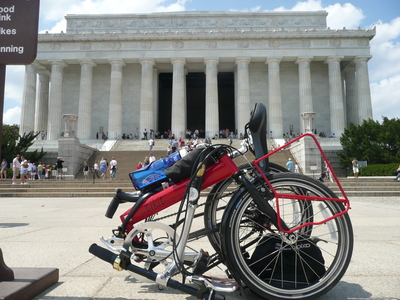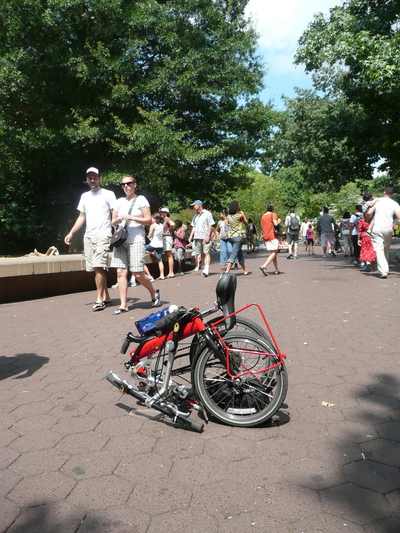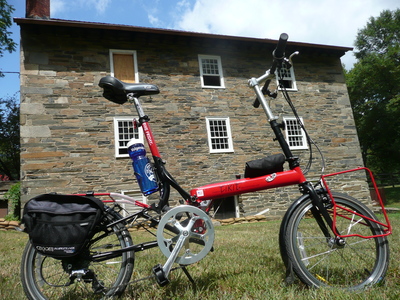There are few multi-month reviews of the bike (Vik's got 1 month, 3 month, and 1 year reviews). So I figure I can put in my own two cents. Below I list various stuff I've discovered in the first four months on the bike. Likes and concerns, necessities and suggestions.
The local fan club is a fun bunch of people too.
and Ride
 The bike rides much more stably than my two Dahon Helii and my friend's Dahon Speed P8. Part of this, I believe, is because the tikit has a moderate amount of trail. And unlike the Dahons, it just doesn't suffer from maddening indeterminant squeaks. It's a much better built machine, and that I've really appreciated.
The bike rides much more stably than my two Dahon Helii and my friend's Dahon Speed P8. Part of this, I believe, is because the tikit has a moderate amount of trail. And unlike the Dahons, it just doesn't suffer from maddening indeterminant squeaks. It's a much better built machine, and that I've really appreciated.
I've recently tested the Brompton M3L and S2L as well: in short, the Tikit rides smoother (despite the Brompton's rear suspension) and is much more stable as well (more trail). And the Brompton is quite cramped compared to my Tikit: in fact, its reach appears to be about the same as a size small Tikit. Those are the tradeoffs to achieve the Brompton's ultrasmall fold, I guess.
I've decided not to install a suspension seatpost. The bike has proven adequately smooth for my purposes. Still, it's far from my (non-suspended) old steel mountain bike.
I can wheelie the tikit.
The size-Large tikit has thicker tubing than the others, notionally to support more weight. My tikit is unusual: it's a size-Medium with the stem of a size-Large (the silver portion), and also has a custom rear seatmast (the red portion) that's of size-Large thick tubing. The seatmast is less bouncy under my weight (205 pounds) than the original. But the big difference is the stem: it's significantly less flexible. If you are buying a size-Medium or perhaps a size-Small, you might ask how much it'd cost for them to throw in a vertical stem tube of size-Large thickness. It's just a hunk of metal. I think Bike Friday ought to use that thickness in the stems of all their tikits, even though it'd increase the weight slightly.
Accessories
Rear rack
A rear rack is a must. It makes the bike stabler when folded. I have a "standard" (low) rear rack, which doesn't take ordinary panniers but does take a box.Front rack
The front rack takes an actual pannier: but I've used it less than the rear rack. It also makes the bike a bit larger when folded (under the transit cover). Looks cool though. People are mystified by it. Some complaints have been made elsewhere that the one-sided front rack is less stable than a two-sided rack when under load. I don't find it an issue in the slightest.Transit Cover
Get the transit cover. You'll be glad you did. I do wish the transit cover was two inches deeper; my rear rack pokes out.Kickstand
Get a kickstand. You'll be glad you did. My kickstand mount has lately tended to loosen on me. I think it's because the kickstand gets some abuse from the constant wrapping with the transit cover. A lock washer or some Locktite should do the trick.Concerns

Seatmast Latch
This is a theoretical potential concern. The seatmast latch is where the seatmast pops and locks into the rear triangle during unfolding. I think it is the potentially weakest point on the bike. The seatmast latch consists of a latch pin, whose outer washer-like rings fit into two parallel latch grooves. The grooves are shaped like cul-de-sacs: they have a little circle at the end. The pin pushes each groove apart, then slides down into the end of the cul-de-sacs, where it's held in place.The concern is that the constant pressure on the latch could wear away the groove metal, widening the diameter of the cul-de-sac. Eventually the pin wouldn't stay locked in place. The issue here is that the groove is not replaceable: it's part of the bike frame. If Bike Friday did their job right, the groove metal would be much harder than the latch pin ring metal, so the rings would wear away instead. I have reason to believe this is the case, as Bike Friday sells replacement rings (for next to nothing) and indicates that they are meant to ultimately wear away. But I don't know for sure.
Vik has mentioned that his latch slides relatively freely, and prefers it like that. I think that would be a safety issue, and it sounds like a worn pin ring. Last, I should mention that if I went off curbs with the worn pin ring, it would occasionally work itself slightly loose, so when I land on the ground again, it'd "pop" back into position. Disconcerting but not of major concern.
I argue: this is a suboptimal solution. Rerouting the hyperfold cable is a simpler and more permanent solution than tying off the derailleur cable.
Hyperfold Cable Routing
The bike was shipped to me with an incorrectly routed hyperfold cable which lay over the gear cable. Folding the bike would cause the hyperfold cable to crimp the gear cable, eventually causing it to malfunction. I rerouted it before it caused permanent damage. Just remove the lock-nut for the hyperfold cable, slide it out, reroute between the other cables and the bottom bracket shell, slide back in, reattach nut. Bike Friday doesn't provide any guidance here, but don't make it too tight: there's a sweet spot between the seatmast becoming resistant to locking (like a spring) and the handlebar stem being maximally stiff. Note: the lock-nut has a nylon insert to give it more friction. Removing and reattaching the lock-nut will probably cause it to loose much of this friction, resulting in more often having to adjust the cable. Any local bike shop should have a 10mm nylon insert lock-nut they can toss your way for free. No doubt Bike Friday can provide one too.Anyway, this absolutely should have been caught at the factory.
Concerns
I tried it: and it works fine! Had to dig deep in my local bike shop's collection of random screws to find one with the right screw diameter and head diameter.
Folding Foot Angle
For a bike this well-designed, my tikit has a surprising little blunder. When folded, the tikit rests on a small foot which juts out diagonally to the ground near the latch groove. This foot is not long enough. If the bike is on a perfectly flat surface, it'll rest on the foot. But if it's on a slightly uneven surface (such as brick or asphalt), it is likely to rest on the latch groove's safety, scratching it up. All Bike Friday had to do was make the foot a centimeter longer or change its angle slightly. There's easily enough space.
Stem Latch
The little U-shaped rest for the folded handlebar stem was made out of too-thin, easily bent metal. Bike Friday is now using thicker ones and says you can snag one from their service department. I shall!Wear Spots
The hyperfold cable is routed down under the bottom bracket shell. There it can wear into the paint as it presses against it (with high strain). Eventual steel-against-steel rubbing is unlikely to be a problem, but I've been experimenting with preventive approaches here. Bike Friday had insulated the cable at this location with a strong bit of heat-shrink tubing, but it gets worn through relatively quickly. I experimented with additional tubing: first more heat-shrink tubing, then some aquarium vacuum hose tubing. It wears through them too. It's not a a big deal, but I think the company ought to install a trough or guide there.Paint wear on cup—a piece of framesaver tape is now applied to the inside of the cup, which works okay."
Wear Spot Non-Concerns
The locking post pops into the tongue (what Bike Friday calls the dinosaur) on the rear triangle to keep the bike folded. When unfolding the bike, a paddle pushes against the tongue to allow the locking pin to pop out. All three of these elements are direct parts of the frame and they wear against each other. They were clearly designed to do this, but they've understandably worn off the paint at specific impact points.
Bag
Attached stuff oughtn't hamper the fold or folded size. I wanted a small bag for the bike, and under-the-seat bags tended to add to the height of the bike under its slip cover when folded. Next I tried handlebar bags: but few attach in a satisfactory way due to the fold and cable location. But I did manage to attach a plain old Axiom Adriondack handlebar bag permanently to the bike. But not to the handlebars. To the far back right side of the rear rack. If it's not overfull, it fits perfectly between the wheels when folded. You can roll with it in folded position as well.Water Bottle Braze-On
To attach both my water bottle holder and tire pump holder to the same braze-ons, I needed to replace the braze-on screws with longer ones: but interestingly the upper screw can't be too long because it impacts on the removable red portion of the seatmast, which is inside the black portion at that point. So I needed to find an odd screw length. Rooting through the extra-screw bin at my local bike shop did the trick.Lights
A rear safety light also caused some head-scratching. The bike is most easily folded and unfolded if you can grab the seatmast full-on—I like to do so directly below the seat. But that's the only place a light could go: any further down and it'd interfere with water bottles. In the name of night riding, I've had to get used to grabbing the post much lower.Reflector
It was either the light or the reflector: they wouldn't both fit plus a water bottle. The reflector's new home is suboptimal but cute: on the curved region under the water bottle, and angled slightly up to reflect car headlights.Shopping Pannier
Bike Friday recommends the Detours Teeco as their front-rack shopping bag pannier of choice. I am less enamored by it. It's a great bag: but it lacks the customary third latch or hook to forcefully attach to the rack. Instead it relies on two large (and loose) vertical tabs. I've found that if I hit a bump or go off a curb, and the bag isn't really weighed down with foodstuffs yet, it'll pop off the front rack. It'd be better if its tabs were completely rubberized too, so as not to scratch the paint. It attaches relatively stably to the rear rack, but then you can't shop with it!With
Brompton